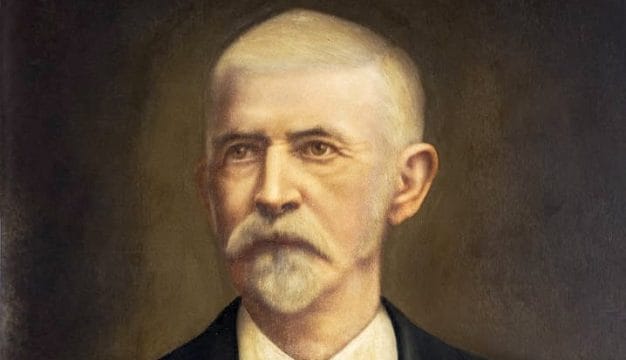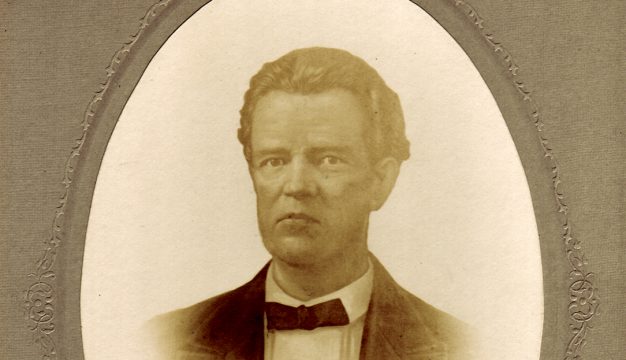James Abercrombie
 James Abercrombie
James Abercrombie (1795-1861) was a member of the Alabama House of Representatives and the Alabama Senate. He later served two terms as a U.S. Congressman representing Alabama's Second Congressional District as a Whig and was a moderate voice on the issue of secession in the early 1850s.
James Abercrombie
James Abercrombie (1795-1861) was a member of the Alabama House of Representatives and the Alabama Senate. He later served two terms as a U.S. Congressman representing Alabama's Second Congressional District as a Whig and was a moderate voice on the issue of secession in the early 1850s.
Abercrombie was born on February 18, 1792 or 1795, in Hancock County, Georgia, to Charles and Edwina Dicey Malinda Booth Abercrombie. (His congressional biography and other sources state his birth year as 1795 but his gravestone says 1792. And some sources mention 9 siblings, but he may have had up to 10.) His father served as an Army officer in the American Revolution and later represented Greene and Hancock Counties in the Georgia State Senate and was the Speaker of the Georgia House of Representatives in 1825. He was a delegate to Georgia's constitutional convention in Louisville on May 30, 1789, and the owner of several very large plantations.
James Abercrombie served as a corporal in Maj. F. Freeman's Squadron of Georgia Cavalry during the War of 1812. He moved to Monroe (present-day Dallas) County in Alabama in 1812. An older brother, Anderson Abercrombie (1786-1867), rose to the rank of adjutant general in the war and fought at Autosee and Calabee Creek during the Creek War of 1813-14. He settled on a large plantation in Russell County, and married Evelina Elizabeth Ross in the area of present-day Montgomery, Montgomery County, on July 27, 1816. They raised four sons and six daughters, with at least one son following in the family political tradition by representing Escambia County in the Florida Legislature.
 Marquis de Lafayette
In 1819, Abercrombie settled in Montgomery County and was elected as a member of the State House of Representatives in 1822 and again in 1824. In 1825, then a captain in the Alabama Militia, he commanded the cavalry that was present when Revolutionary War hero the Marquis da la Lafayette visited Fort Mitchell on his tour through the eastern United States. Also that year, he was elected to the Alabama Senate and served for nine years, until 1833 when he was removed for having moved out of his district and into Creek Territory. In 1838, he moved to Russell County and was elected again to the State House of Representatives, serving until 1839. He became an influential member of the Whig Party, served in the Alabama Senate from 1847 to 1850, and was a delegate to the first of two 1850 Nashville Conventions that brought together pro-slavery southerners to discuss the issue of secession, on which he was considered a Unionist. Those meetings would lead to the Missouri Compromise of 1850. About this time, he helped organize the Mobile and Girard (present-day Phenix City) Railroad and tried to secure for it a federal land grant. The railroad aimed to circumvent Montgomery as a center of commerce but ran no farther than Troy, Pike County, after the Civil War, and was abandoned.
Marquis de Lafayette
In 1819, Abercrombie settled in Montgomery County and was elected as a member of the State House of Representatives in 1822 and again in 1824. In 1825, then a captain in the Alabama Militia, he commanded the cavalry that was present when Revolutionary War hero the Marquis da la Lafayette visited Fort Mitchell on his tour through the eastern United States. Also that year, he was elected to the Alabama Senate and served for nine years, until 1833 when he was removed for having moved out of his district and into Creek Territory. In 1838, he moved to Russell County and was elected again to the State House of Representatives, serving until 1839. He became an influential member of the Whig Party, served in the Alabama Senate from 1847 to 1850, and was a delegate to the first of two 1850 Nashville Conventions that brought together pro-slavery southerners to discuss the issue of secession, on which he was considered a Unionist. Those meetings would lead to the Missouri Compromise of 1850. About this time, he helped organize the Mobile and Girard (present-day Phenix City) Railroad and tried to secure for it a federal land grant. The railroad aimed to circumvent Montgomery as a center of commerce but ran no farther than Troy, Pike County, after the Civil War, and was abandoned.
 David Clopton
In 1851, Abercrombie defeated secessionist John Cochran to take the seat left open by Henry W. Hilliard's retirement to represent Alabama's Second Congressional District. It largely consisted at the time of counties in southeast Alabama, stretching from what is now Lee County southwest to Covington County. Unlike Cochran, Abercrombie was more equivocal on secession, voicing support for the Union and constitutional rights of the South. He endorsed the "Georgia Platform" in which Georgia leaders pledged support for the Union and acceptance of the Compromise of 1850 in exchange for the federal government enforcing the Fugitive Slave Act and supporting slavery's expansion into new territories to avoid Georgia's secession. In the presidential election of 1852, Abercrombie withheld support for Whig candidate Winfield Scott for his weak stance on southern rights. Abercrombie was reelected to the Thirty-third Congress in 1853, defeating David Clopton. Discouraged by the district's impending reapportionment in 1855, he did not run for reelection in 1854. The open seat was won by Eli Sims Shorter.
David Clopton
In 1851, Abercrombie defeated secessionist John Cochran to take the seat left open by Henry W. Hilliard's retirement to represent Alabama's Second Congressional District. It largely consisted at the time of counties in southeast Alabama, stretching from what is now Lee County southwest to Covington County. Unlike Cochran, Abercrombie was more equivocal on secession, voicing support for the Union and constitutional rights of the South. He endorsed the "Georgia Platform" in which Georgia leaders pledged support for the Union and acceptance of the Compromise of 1850 in exchange for the federal government enforcing the Fugitive Slave Act and supporting slavery's expansion into new territories to avoid Georgia's secession. In the presidential election of 1852, Abercrombie withheld support for Whig candidate Winfield Scott for his weak stance on southern rights. Abercrombie was reelected to the Thirty-third Congress in 1853, defeating David Clopton. Discouraged by the district's impending reapportionment in 1855, he did not run for reelection in 1854. The open seat was won by Eli Sims Shorter.
After retiring from political office, Abercrombie relocated to Pensacola, Florida, in 1856. There, he became a contractor, supplying bricks to the U.S. government. Although, he did not serve in any other political offices, as late as 1859 he visited Montgomery to assist former governor Benjamin Fitzpatrick's campaign for reelection to the U.S. Senate. Abercrombie died on July 2, 1861, in Pensacola and is buried in Linwood Cemetery in Columbus, Georgia.
Further Reading
- Denman, Clarence Phillips. The Secession Movement in Alabama. Montgomery: Alabama Department of Archives and History, 1933.
- Dorman, Lewy. Party Politics in Alabama from 1850 through 1860. Tuscaloosa: University of Alabama Press, 1995.
- Thornton, J. Mills, III. Politics and Power in a Slave Society: Alabama, 1800-1860. Baton Rouge: Louisiana State University Press, 1978.



